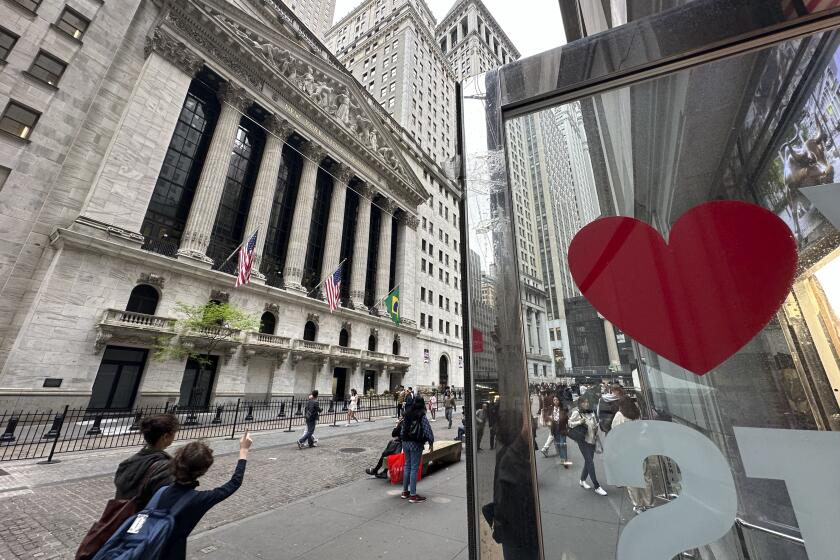If it’s a bubble, it’s still built on a boom
WAITING for the end of the world as we know it hasn’t worked well as an investment strategy the last few years.
So how about this summer?
Things have been positively wondrous for global stock markets in recent months, but equities began to falter late last week. Wall Street has been echoing with warnings of trouble ahead.
Unfortunately, many of these warnings are little more than blinding glimpses of the obvious.
Former Federal Reserve Chairman Alan Greenspan helped trigger the latest flutter in share prices, particularly in emerging markets, after he said of the wild rally in Chinese stocks, “There is going to be a dramatic contraction at some point.”
That’s an old economists’ trick: Describe the event, but leave it open-ended. Someday you’re bound to be right.
Warnings about hot markets do serve a purpose, of course. They may keep people from becoming, well, irrationally exuberant and dumping all of their money into one asset just before it collapses.
But there’s a danger that investors who listen to constant fretting about how bad things might get in the economy and markets can end up paralyzed with fear and unwilling to take even minimal risks. That may cost them dearly in terms of their long-term financial health.
After the blue-chip Standard & Poor’s 500 index lost nearly 50% of its value from March 2000 to October 2002, investors now know in retrospect that they should have been buying stocks with both hands. But fear reigned until the market turned up decisively in 2003.
A basic truth about investing is that there’s never a good time to buy -- meaning, there’s always something to worry about. That’s life.
Yet look at what the world’s stock markets have overcome in recent years: record-high oil prices, rising short-term interest rates, devastating terrorist attacks in Madrid (2004) and London (2005) and, most recently, a serious U.S. housing slump.
There should be a fundamental reason stock prices have forged ahead, and here it is: The global economy has continued to expand. Consumers and businesses have continued to spend, which in turn has underpinned corporate earnings.
To be sure, easy money also is driving markets. Despite central-bank credit tightening, lenders around the planet remain eager to lend and borrowers remain eager to borrow. One result is plenty of capital for buyout firms, which are snapping up companies everywhere, thereby benefiting the shares of other firms (on the hope that a takeover bid materializes).
Some Wall Street veterans say easy money has led to rank speculation and dangerous bubbles in asset prices everywhere they look.
“From Indian antiquities to modern Chinese art; from land in Panama to Mayfair; from forestry, infrastructure and the junkiest bonds to mundane blue chips; it’s bubble time!” wrote Jeremy Grantham, head of Boston money manager GMO, in a letter to clients last month.
We are living, he said, in “the first truly global bubble.”
Maybe. But some people said much the same thing two years ago, when commodities, stocks and real estate were streaking in unison. As for Grantham, whose firm manages $145 billion, he has been negative on U.S. stocks for four years, so he may have left a lot of money on the table.
What a pessimistic investor calls a bubble, an optimist might say is just a fantastic, and justifiable, bull market. That’s the view of Edward Yardeni, who heads his own investment and economic research firm in New York and who, like Grantham, does a lot of big thinking on financial markets.
Yardeni believes there has never been a global economic boom on the current scale, with China, India and other developing nations now full-on capitalists and with money flowing so easily and quickly into investment opportunities worldwide.
“If this is the greatest global boom of all times, then why wouldn’t we have the greatest global bull markets in stocks and commodities of all times?” Yardeni asks.
And though experienced investors are conditioned to run the other way when someone declares a “new era” for the economy or markets, the fact is that sometimes it is a new era. Case in point: What else would you call the 20 years after 1980, when U.S. inflation and interest rates were in a sustained decline and stocks mostly marched higher?
To be a buyer of stocks in general now, you pretty much have to believe we’re in a new era of global growth -- and that we’re somewhere near the start or in the middle of it, not approaching a calamitous end.
Even if Yardeni is right about an ongoing boom, however, there are going to be serious economic and market disruptions along the way. At the moment, the deepening trade disputes between the U.S. and China pose one significant risk. So do rising bond yields in the U.S. and Europe and decelerating corporate earnings growth.
A year ago, jitters over frenzied gains in stocks and fear of inflation pressures and rising interest rates helped to trigger a five-week pullback in share prices around the globe. The declines were much worse in many foreign markets than in the U.S., exposing the soft underbelly of overseas investing: a lack of liquidity when you need it most.
The next market disruption, whatever the trigger, may play out much the same. That’s why many pros continue to warn clients away from emerging markets for the time being, despite their longer-term promise.
If stocks scare you at these levels, then the prudent decision is to put off buying, and perhaps to start pruning.
But you have to allow for the possibility, or perhaps probability, that the world as we know it isn’t ending -- and that the global economy will keep expanding, and stock market pullbacks will be opportunities to pick up appealing long-term investments for less.






